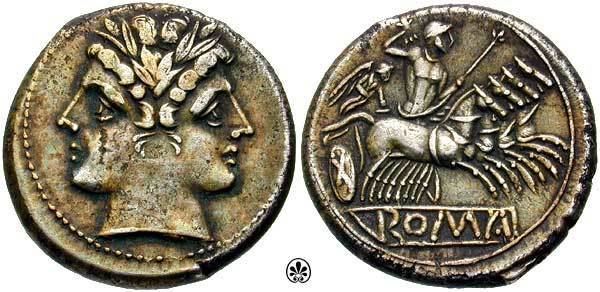 | ||
The quadrigatus was a medium-sized silver coin produced by the Roman Republic during the 3rd century BC. The obverse featured a young janiform bust and the reverse featured Victory driving a quadriga (four-horse chariot), giving the coin its name, with the inscription "ROMA" below.
The coin weighed about 6.8 grams (6 scruples), consistent with a didrachma. The coin was minted from c. 241 to 235 BC until shortly before the introduction of the denarius (211 BC). Gold coins of similar style were issued at this time (staters and half-staters) which featured the same obverse type as the quadrigatus and the reverse type of two soldiers performing an oath over a third soldier holding pig, with the inscription "ROMA" below. The choice of Janus for these coins is believed to coincide with the closing of the doors of the Temple of Janus, indicating the absence of warfare, a rare occasion. Michael Crawford, however, has suggested that the janiform head represents the Dioscuri, since Janus is usually a mature and bearded figure.
Roman-era historians such as Livy and Plutarch often refer to these early coins as denarii, but modern numismatic references consider these coins as anonymous Roman silver, produced before the standardization of the denarius around 211 B.C. The name quadrigatus comes from the quadriga or four-horse chariot on the reverse, which was the prototype for the most common designs used on Roman silver coins for the next 150 years.
The victoriatus was a later coin of the same fabric that was valued at half a quadrigatus (3 scruples).
